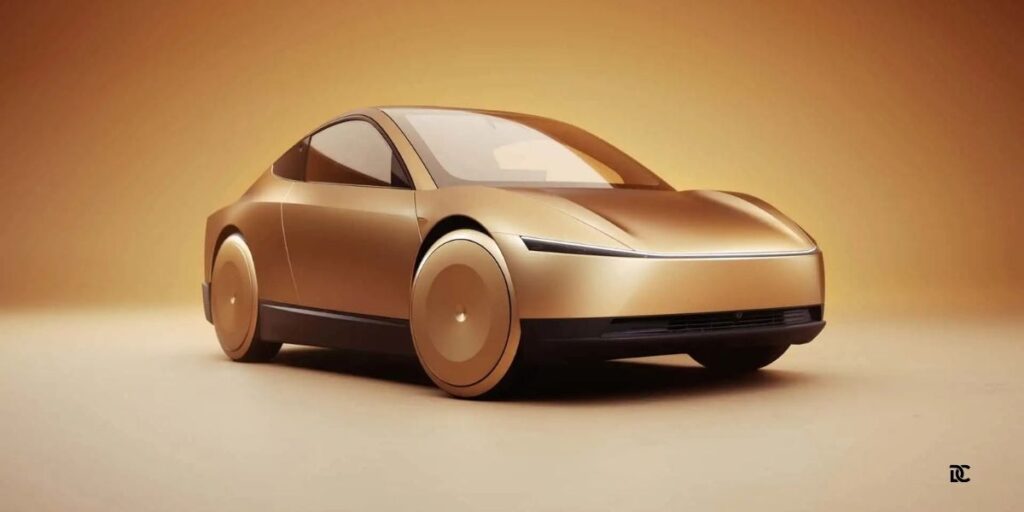At Tesla’s “We, Robot” event in Los Angeles on Thursday, the spotlight shifted unexpectedly. Elon Musk and his team introduced not only the highly anticipated Cybercab but also an entirely new concept: the Robovan. This surprising reveal has captured the imagination of many and given a glimpse of what Tesla envisions for the future of autonomous transport.
The Robovan is a peculiar-looking, dustbuster-like vehicle designed to move large groups of people autonomously. It was a surprise last-minute addition to an event focused on the Cybercab, Tesla’s long-hyped autonomous taxi. Its design may look unconventional, but it’s clear Tesla wants to revolutionize not just personal transportation but public transit as well.

The star of the night was originally intended to be the Cybercab, Tesla’s vision for the future of taxis. This autonomous two-door coupe has butterfly doors, making it as much of a statement piece as it is a vehicle. With no steering wheel or pedals, it’s entirely dependent on Tesla’s autonomous technology, shifting the driver’s role to that of a relaxed passenger.
The Cybercab borrows its front end from the Cybertruck, but it’s much smaller and boasts a sleeker, aerodynamic shape. With just two seats and a giant screen in the middle of the dashboard, it’s clearly designed for efficiency and style. It’s an ambitious leap towards making autonomous ride-hailing a reality, and Musk confidently stated that it will be available for under $30,000.
Also Read
But the real surprise of the event was the Robovan—a large, electric people mover built to handle over 10 passengers at a time. While the specs were kept under wraps, the Robovan’s purpose was clear. It’s intended to autonomously ferry large groups, potentially transforming public transit as we know it. Tesla’s goal with the Robovan seems to be bridging the gap between private and public autonomous vehicles.
Tesla’s presentation of the Robovan is a step into a future where buses and mass transit can be as cutting-edge as personal vehicles. The Robovan has no steering wheel, no pedals, and no driver; instead, it relies fully on Tesla’s autonomous driving capabilities. Though Musk didn’t disclose if it would be available for individual buyers, its potential as a people-moving solution in crowded urban areas is enormous.
The Robovan’s unveiling came as a complete surprise, drawing gasps from the crowd and a wave of interest across social media. Many are speculating whether it could be used in cities where conventional buses are inefficient or as a more luxurious mass transit option. For now, the specifics are vague, but Tesla’s vision is clear—this is transportation for the future, automated and sustainable.
The Cybercab
Meanwhile, the Cybercab also wowed attendees. With its futuristic design and butterfly doors, it aims to make autonomous ride-hailing stylish and accessible. Elon Musk did not reveal performance or range estimates for the Cybercab, but he mentioned that it will feature inductive charging. This means that there won’t be a physical plug for charging, making the entire experience seamless.

The target price of Cybercab is under $30,000, which is meant to make it affordable to a wide range of consumers. Elon Musk has always emphasized his vision of making electric vehicles accessible, and the Cybercab seems like a step in that direction. The goal is to have these vehicles on the road by 2026, although Tesla’s optimistic timeline is well known—it might take longer.
Elon Musk also discussed Tesla’s plans for fully autonomous operations in California and Texas. The idea is to begin using existing models like the Model 3 and Model Y as early as next year. This is intended to pave the way for the more advanced Cybercab and Robovan models that will come later. Musk admitted to being optimistic about timelines in the past, but he remains confident that autonomous Teslas are the future.
The Robovan and Cybercab represent a significant step in Tesla’s quest to dominate autonomous mobility. The Robovan, in particular, raises many interesting possibilities for the future of public transport. Imagine a fleet of robots efficiently moving people around cities, reducing traffic congestion, and providing a cleaner alternative to traditional buses.
The design of the Robovan is intentionally minimalist, but it promises a spacious interior meant to accommodate many passengers comfortably. Its purpose is simple: to move people in large numbers autonomously and sustainably. This aligns with Musk’s broader goal of reducing humanity’s dependence on fossil fuels and embracing a future of clean, electric transport.
The fact that Tesla chose to reveal the Robovan at a time when all eyes were on the Cybercab suggests that the company sees a future in revolutionizing public transit as much as personal cars. By expanding beyond individual electric vehicles and into mass transit solutions, Tesla is positioning itself at the forefront of transportation innovation.
Public response to the Robovan has been mixed. Some are excited by the prospect of a future where mass transit is as advanced as personal vehicles, while others question the practicality and safety of fully autonomous public transit. These are questions that Tesla will need to answer as development continues, but for now, the Robovan has certainly grabbed attention.
For a company that started by making sleek electric sports cars, Tesla has certainly expanded its ambitions. The Robovan is a bold move into uncharted territory, aiming to make public transportation futuristic, sustainable, and autonomous. Whether it becomes a common sight in cities remains to be seen, but the potential is undeniably there.
The Robovan and Cybercab are symbolic of Musk’s relentless drive to innovate. Tesla has made significant strides in autonomous technology, and these new vehicles are the latest testament to that progress. By reimagining both private and public transport, Tesla is pushing the boundaries of what vehicles can do and how they can serve society.
The Robovan may not have been what the audience expected at the “We, Robot” event, but it was certainly what they remembered. Its quirky, bus-like design may be unconventional, but it fits perfectly with Tesla’s vision of future-forward transportation. If nothing else, it shows that Tesla is not content to rest on its laurels and is constantly searching for new ways to innovate.
As the night drew to a close, the Robovan and Cybercab represented more than just new models; they were a glimpse into Tesla’s vision for a fully autonomous future. Elon Musk may have been overly optimistic about timelines in the past, but there’s no denying the excitement and potential of these new projects. The Robovan, in particular, opens up new possibilities for public transit that are as imaginative as they are ambitious.
Tesla’s ambition to redefine transportation doesn’t end with personal cars. The Robovan could very well be the future of mass transit, and the Cybercab could make autonomous taxis commonplace. Both vehicles embody the spirit of innovation that Tesla has come to be known for—pushing boundaries and challenging what we think is possible in the world of transportation.
As we wait for 2026 to see these vehicles on the road, one thing is certain: Tesla is determined to change how we think about getting from point A to point B. With the Robovan and Cybercab, Elon Musk is not just offering new vehicles—he’s offering a vision of a future where transportation is autonomous, electric, and accessible to all.






